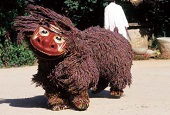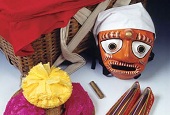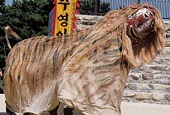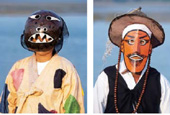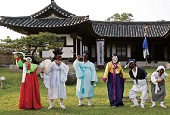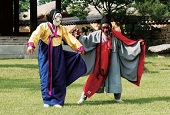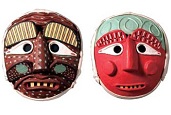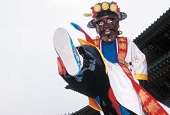View this article in another language
- 한국어
- English
- 日本語
- 中文
- العربية
- Español
- Français
- Deutsch
- Pусский
- Tiếng Việt
- Indonesian
This is the seventh part in our series, “Masks & the Mask Dance” published in partnership with the National Research Institute of Cultural Heritage
Kkun: People who embrace the mask dance as part of their lives
1. The transmission & preservation of the mask dance
Traditional mask dances are a definitive aspect of Korean cultural heritage. They have enjoyed great support and love from many people. However, they had to withstand enormously adverse circumstances before achieving such popularity.
While traditional mask dances reached their peak at the end of the 19th century, the traditions were nearly lost when society passed through difficult times during the colonial period. By the 1960s, however, the art form had been restored through the vigorous efforts of folklorists, mask dance researchers and performers.
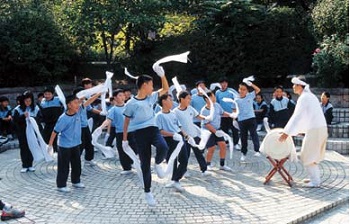 Mask dance performers came from various social classes, but most of them were farmers drawn from the immediate vicinity. However, around Yangju, mask dance performances included many participants from the lowest classes, such as slaves in the government's employ. In the Songpa region, there were great numbers of local merchants performing the regional variation of the mask dance. The Bukcheong lion dance is a lion-mask dance performed on the fifteenth day of the first lunar month in villages around the Bukcheong region in Hamgyeong Province, in what is now North Korea. Residents of each village, generally local farmers, made their own versions of lion masks and visited each house in the village while performing the dance. Residents of Bukcheong who fled from North Korea during the Korean War (1950-1953) established the Bukcheong Lion Mask Dance Preservation Association in 1960 and began to transmit their lion dance tradition to the next generation, with the help of members who retained some experience of performing the dance authentically.
Mask dance performers came from various social classes, but most of them were farmers drawn from the immediate vicinity. However, around Yangju, mask dance performances included many participants from the lowest classes, such as slaves in the government's employ. In the Songpa region, there were great numbers of local merchants performing the regional variation of the mask dance. The Bukcheong lion dance is a lion-mask dance performed on the fifteenth day of the first lunar month in villages around the Bukcheong region in Hamgyeong Province, in what is now North Korea. Residents of each village, generally local farmers, made their own versions of lion masks and visited each house in the village while performing the dance. Residents of Bukcheong who fled from North Korea during the Korean War (1950-1953) established the Bukcheong Lion Mask Dance Preservation Association in 1960 and began to transmit their lion dance tradition to the next generation, with the help of members who retained some experience of performing the dance authentically.
The Haeseo-style mask dances are traditional to Hwanghae Province in what is now North Korea. They include the Bongsan mask dance, the Gangnyeong mask dance and the Eunyul mask dance. They have all been transmitted mainly by individuals who escaped from North Korea during the war. These mask dances were developed around commercial markets where agricultural and marine products were sold and traded. Merchants and patrons willing to sponsor a performance could easily be found in these marketplaces. In this region, mask dances were performed annually by professional performers and talented local farmers for the Dano spring festival.
Mask dances originating in regions now located in North Korea were introduced to the south by performers who escaped from North Korea during the war. They struggled to keep their traditions alive. However, thanks to their untiring efforts, northern mask dances contributed to alleviating their homesickness and strengthening the overall sense of belonging among the displaced. They have grown into a form of folk performance art that enmjoys considerable popularity today.
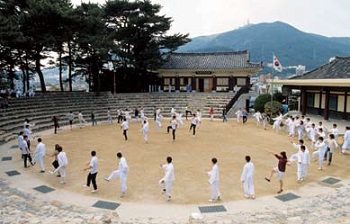 There are two regional variants of mask dances indigenous to Seoul and to Gyeonggi Province: the Yangju Byeosandae Nori performed by local government employees and the Songpa Sandae Nori performed by professional entertainment troupes in marketplaces. The second type of mask dances were originally practiced mainly by professional performers, but today local residents and ordinary citizens take the lead in sustaining the tradition. While retaining their original characteristics, the second type of mask dances have adapted themselves to the increasingly urbanized environment, growing into a regional form of performance art.
There are two regional variants of mask dances indigenous to Seoul and to Gyeonggi Province: the Yangju Byeosandae Nori performed by local government employees and the Songpa Sandae Nori performed by professional entertainment troupes in marketplaces. The second type of mask dances were originally practiced mainly by professional performers, but today local residents and ordinary citizens take the lead in sustaining the tradition. While retaining their original characteristics, the second type of mask dances have adapted themselves to the increasingly urbanized environment, growing into a regional form of performance art.
In southern Korea, mask dance performances were staged to celebrate the return of spring on the first full moon of the lunar year. These regional mask dance variants have long been cherished by local citizens and performed for entertainment or as part of shamanic rituals.
Although the transmission of mask dance traditions was interrupted for an extended period, researchers, performers and local residents managed to revive the traditions in the 1960s and 1970s, successfully developing the traditional mask dance as a definitive genre of folk art. As a result, mask dances as a whole have now been designated as an Important Intangible Cultural Property and regional governments have designated their own masters and institutions for the transmission and preservation of the art form.
Today, members of preservation associations and performers are making great efforts to sustain the effective transmission and preservation of all types of mask dances. In particular, each preservation association has established a permanent performance venue, offers regular performances for the general public and holds a variety of events, including invitational performances, at home and abroad. In addition, to hand down the traditions of the mask dances to future generations, the associations provide "experience programs" for elementary and secondary school students and operate elite training courses for professional performers.
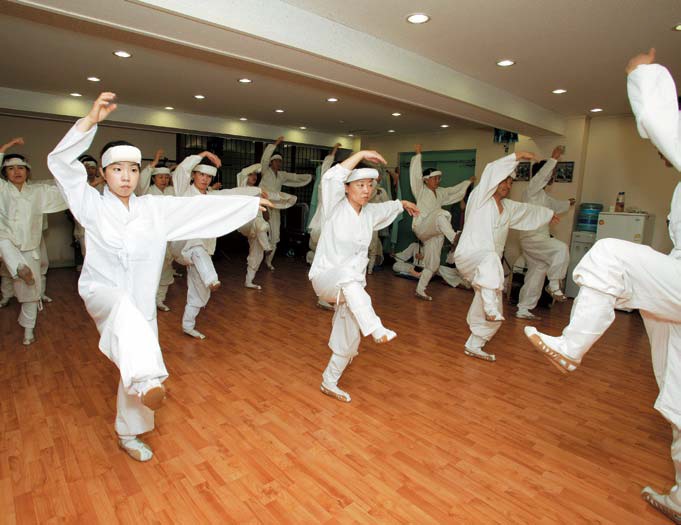
* This series of article has been made possible through the cooperation of the National Research Institute of Cultural Heritage. (Source: Intangible Cultural Heritage of Korea)
Kkun: People who embrace the mask dance as part of their lives
1. The transmission & preservation of the mask dance
Traditional mask dances are a definitive aspect of Korean cultural heritage. They have enjoyed great support and love from many people. However, they had to withstand enormously adverse circumstances before achieving such popularity.
While traditional mask dances reached their peak at the end of the 19th century, the traditions were nearly lost when society passed through difficult times during the colonial period. By the 1960s, however, the art form had been restored through the vigorous efforts of folklorists, mask dance researchers and performers.

Elementary school students practice a mask dance.
The Haeseo-style mask dances are traditional to Hwanghae Province in what is now North Korea. They include the Bongsan mask dance, the Gangnyeong mask dance and the Eunyul mask dance. They have all been transmitted mainly by individuals who escaped from North Korea during the war. These mask dances were developed around commercial markets where agricultural and marine products were sold and traded. Merchants and patrons willing to sponsor a performance could easily be found in these marketplaces. In this region, mask dances were performed annually by professional performers and talented local farmers for the Dano spring festival.
Mask dances originating in regions now located in North Korea were introduced to the south by performers who escaped from North Korea during the war. They struggled to keep their traditions alive. However, thanks to their untiring efforts, northern mask dances contributed to alleviating their homesickness and strengthening the overall sense of belonging among the displaced. They have grown into a form of folk performance art that enmjoys considerable popularity today.

University students practice a traditional mask dance.
In southern Korea, mask dance performances were staged to celebrate the return of spring on the first full moon of the lunar year. These regional mask dance variants have long been cherished by local citizens and performed for entertainment or as part of shamanic rituals.
Although the transmission of mask dance traditions was interrupted for an extended period, researchers, performers and local residents managed to revive the traditions in the 1960s and 1970s, successfully developing the traditional mask dance as a definitive genre of folk art. As a result, mask dances as a whole have now been designated as an Important Intangible Cultural Property and regional governments have designated their own masters and institutions for the transmission and preservation of the art form.
Today, members of preservation associations and performers are making great efforts to sustain the effective transmission and preservation of all types of mask dances. In particular, each preservation association has established a permanent performance venue, offers regular performances for the general public and holds a variety of events, including invitational performances, at home and abroad. In addition, to hand down the traditions of the mask dances to future generations, the associations provide "experience programs" for elementary and secondary school students and operate elite training courses for professional performers.

Members of a preservation association practice the basic mask dance steps.
* This series of article has been made possible through the cooperation of the National Research Institute of Cultural Heritage. (Source: Intangible Cultural Heritage of Korea)
